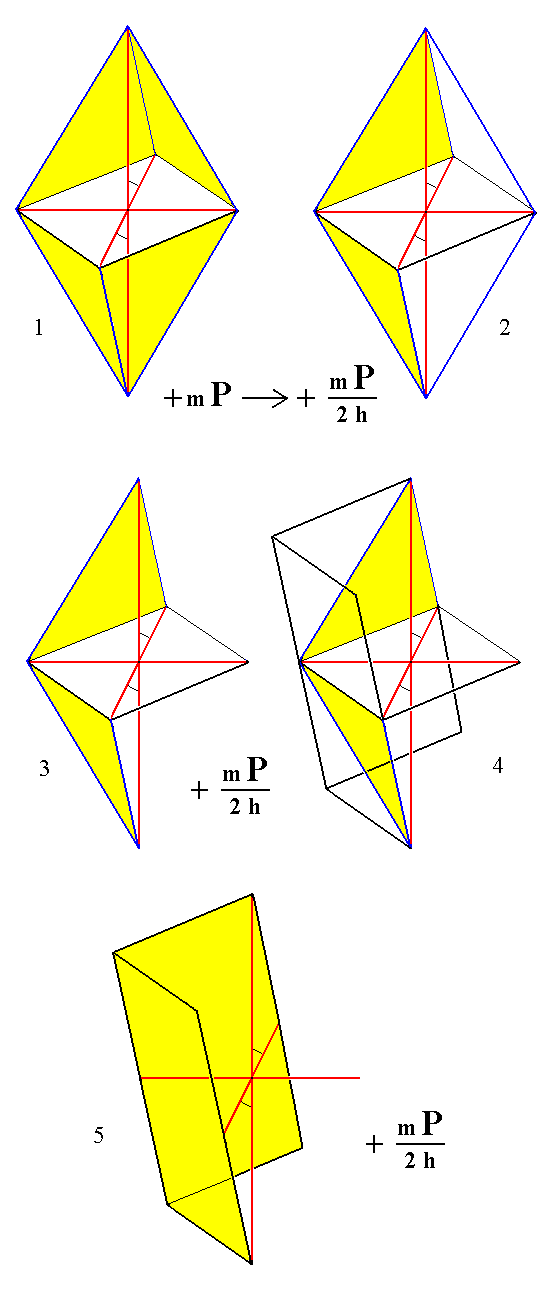
back to homepage(Alternative name : Monosymmetric System)
Recall from Part One that the holohedric Forms were the following :
Generalized Monoclinic Protohemipyramid.
Generalized Monoclinic Clinohemipyramid.
Generalized Monoclinic Orthohemipyramid.
Monoclinic Protoprism.
Generalized Monoclinic Clinoprism.
Generalized Monoclinic Orthoprism.
Generalized Monoclinic Clinodome.
Generalized Monoclinic Orthohemidome.
Monoclinic Clinopinacoid.
Monoclinic Orthopinacoid.
Monoclinic Basic Pinacoid.
MEROHEDRIC APPROACH
We shall derive the Forms of the present Class, the Monoclinic-sphenoidic Class (= Hemimorphous Division of the Monoclinic Crystal System), by subjecting the listed holohedric Forms one by one to hemimorphy, which -- as has been said -- means that the mirror plane is suppressed.
From the holohedric monoclinic protohemipyramid we can derive the monoclinic hemimorphous prototetartopyramid by subjecting it to hemimorphy. Figure 1 shows a possible effect of the suppression of the mirror plane. The resulting shape turns out to be the left half of a tilted prism, which could be expected because a monoclinic hemipyramid is equivalent to a tilted monoclinic prism (See Figure 6a of Part One). So the hemimorphous Form, derived from the protohemipyramid, consists of two faces, each of which intersects all three crystallographic axes, and can also be called a monoclinic sphenoid.

Figure 1.
(1). The positive derived holohedric protohemipyramid. It has a vertical mirror plane, containing the clino and vertical crystallographic axes.
(2). Halving of the number of faces in virtue of the suppression of the mirror plane.
(3). The result of this halving. Two faces are left, constituting the new (hemimorphous) Form.
(4). Extension of the two faces (which does not make any difference crystallographically).
(5). The resulting figure indicates that the shape of the hemimorphous Form is that of half an oblique prism, and is called a Monoclinic Sphenoid (or Prototetartopyramid).
Crystallographic axes are indicated by red lines. The sigh "2h" in the Naumann symbol indicates that hemimorphy has been applied.
A second possible hemimorphous Form can be derived from the right half of the holohedric Protohemipyramid.
In the same way the corresponding negative Forms can be derived (See Figure 1a).
The negative hemimorphous Form, derived from the negative holohedric monoclinic protohemipyramid, looks like the positive one but is tilted in a slightly different direction. In the next Figure we will derive such a negative Form.

Figure 1a.
(1). The holohedric derived (i.e. m is unequal to 1) negative Monoclinic Protohemipyramid. This is a Form consisting of four faces, namely two upper front faces [uvx] and [vwx], and two lower back faces [uyz] and [ywz]. From this Form will be derived the corresponding negative hemimorphous Form.
(2). Removal of the faces on the right side of the hemipyramid, expressing the suppression of the mirror plane.
(3). Extension of the remainig faces (which does not change them crystallographically) in order to make the shape of the hemimorphous Form more clearly stand out.
(4). Completion of the construction, resulting in the negative Monoclinic Prototetartopyramid.
(5). A shortened version of the constructed Form (the shortening does not change it crystallographically).
From the holohedric monoclinic clinohemipyramid a monoclinic hemimorphous clinotetartopyramid can be derived in the same way, when hemimorphy is applied. Also this Form is a (kind of) monoclinic sphenoid. See Figure 2.

Figure 2.
(1). A Monoclinoc Clinohemipyramid.
(2). Extension of two (of the four) faces.
(3). Suppression of the other two faces.
(4). The resulting Monoclinic Clinotetartopyramid, having the shape of the left half of a tilted prism.
A second possible hemimorphous Form can be derived from the right half of the holohedric Clinohemipyramid.
In the same way the corresponding negative Forms can be derived.
From the holohedric monoclinic orthohemipyramid can, in the same way, be derived the monoclinic hemimorphous orthotetartopyramid when hemimorphy is applied. And also this Form is a (kind of) monoclinic sphenoid. See Figure 3.

Figure 3.
(1). Derivation of the holohedric derived (i.e. derived from mP rather than from P) Monoclinic Orthohemipyramid, from which in turn will be derived its hemimorphous Form.
(2). The holohedric Monoclinic Orthohemipyramid.
(3). Construction (derivation) of the Monoclinic Orthotetartopyramid from the Orthohemipyramid by suppressing two faces (this suppression expresses the dropping of the mirror plane) and extending the other two faces.
(4). Final result of the derivation. The new Form consists of two faces making up the left half of a tilted prism.
A second possible Form can be derived consisting of the right half of the Orthohemipyramid.
In the same way the corresponding negative Forms can be derived.
From the holohedric monoclinic protoprism can be derived the left or right half of such a prism, i.e. a Form consisting of two faces parallel to the vertical crystallographic axis. We can call such a hemimorphous Form a protohemiprism. See Figure 4.

Figure 4.
(1). The holohedric Monoclinic Protoprism.
(2). Removal of two faces, expressing the suppression of the mirror plane (containing the clino and vertical axes). The result is the Monoclinic Protohemiprism.
(3). The crystallographic axes removed.
In the same way a second Form can be derived, consisting of the right halve of the holohedric Protoprism.
From the holohedric monoclinic clinoprism can, in the same way, be derived a monoclinic clinohemiprism when it is subjected to hemimorphy. See Figure 5.
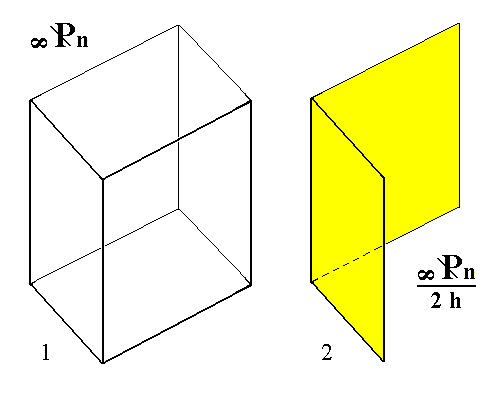
Figure 5.
(1). A holohedric Monoclinic Clinoprism.
(2). The Monoclinic Clinohemiprism, derived from (1).
It is a Form consisting of two faces parallel to the vertical crystallographic axis.
In the same way also a second Form can be derived consisting of the right half of the holohedric Clinoprism.
From the holohedric monoclinic orthoprism can be derived the monoclinic orthohemiprism when it is subjected to hemimorphy. Again the resulting Form will consist of one half of the holohedric orthoprism and thus consisting of two vertical faces. See Figure 6.
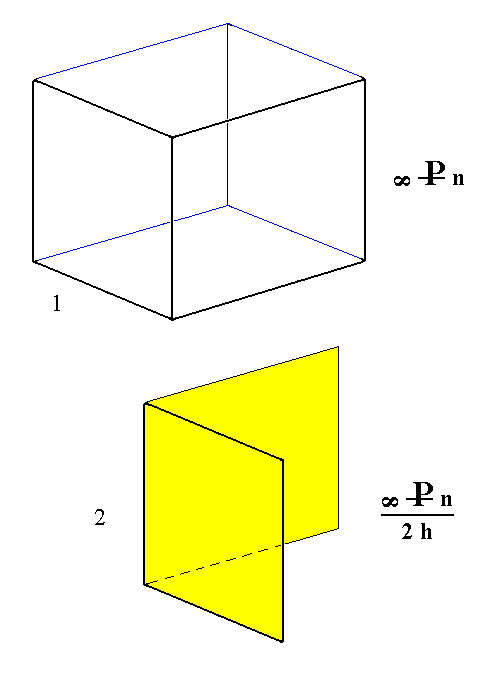
Figure 6.
(1). The holohedric Monoclinic Orthoprism.
(2). The Monoclinic Orthohemiprism.
A second possible Form can be derived consisting of the right half of the holohedric Orthoprism.
From the holohedric monoclinic clinodome can be derived a monoclinic clinohemidome when subjecting it to hemimorphy. The clinohemidome can be either the right half or the left half of the holohedric clinodome. It consists of two faces parallel to the clino axis.
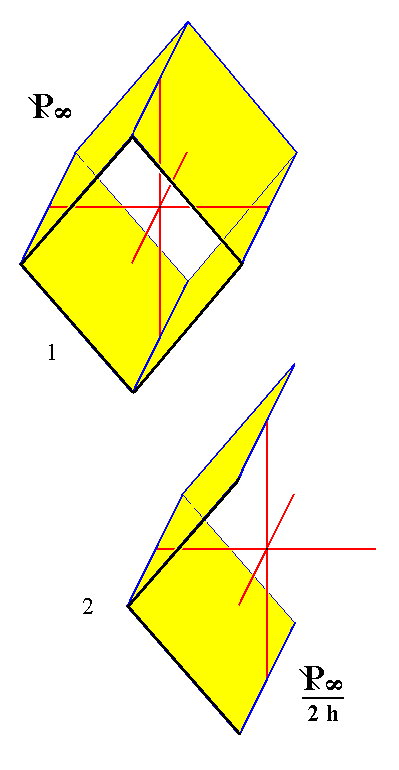 |
Figure 7. (1). The holohedric (primary) Clinodome. (2). The monoclinic (primary) Clinohemidome. This Form consists of the left half of the holohedric Clinodome. A second possible Form consists of the right half of the holohedric Clinodome. |
From the monoclinic orthohemidome can be derived the hemimorphous orthohemidome when hemimorphy is applied. Because the suppressed mirror plane is perpendicular to the faces of the holohedric orthodome its suppression does not affect the external shape. So the hemimorphous orthohemidome still consists of two faces parallel to the ortho axis as did the holohedric one. See Figure 8.
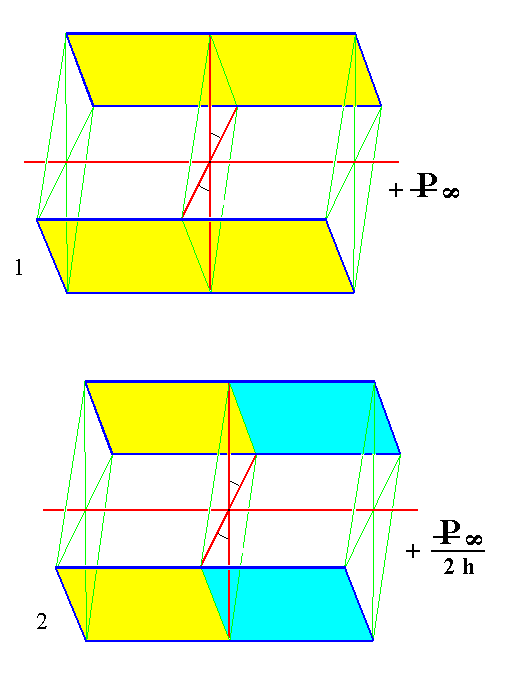
Figure 8.
(1). The holohedric (primary) positive Monoclinic Orthohemidome.
(2). The hemimorphous (primary) positive Monoclinic Orthohemidome.
Its external shape is unchanged, but its symmetry is lowered accordingly, which means the suppression of the mirror plane, (this absence) indicated by coloring.
In the same way we can derive a hemimorphous Monoclinic Orthohemidome from a negative holohedric Monoclinic Orthohemidome. See Figure 9.
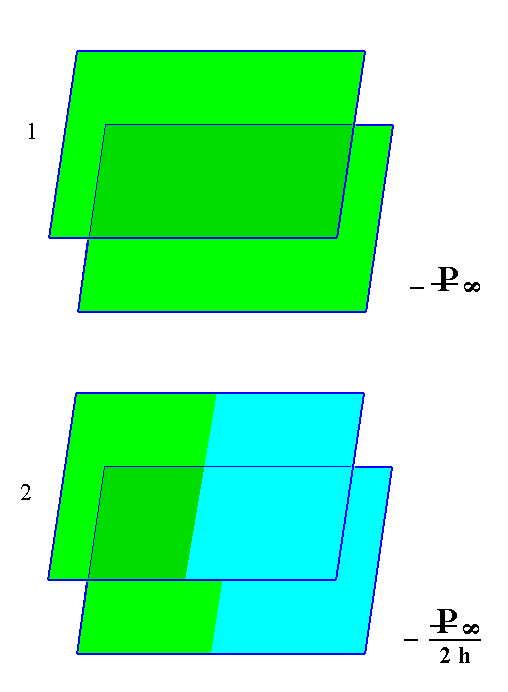
Figure 9.
(1). The holohedric (primary) negative Monoclinic Orthohemidome.
(2). The hemimorphous (primary) negative Monoclinic Orthohemidome.
Also this Form consists of two faces parallel to the ortho axis, with a lowered symmetry with respect to the corresponding holohedric Form.
From the holohedric monoclinic clinopinacoid can be derived a monoclinic pedion when subjected to hemimorphy. The holohedric Form, consisting of a vertical face pair parallel to the clino axis decays into two independent single vertical faces, parallel to the clino axis, i.e. into two Forms each consisting of just one face. See Figure 10.
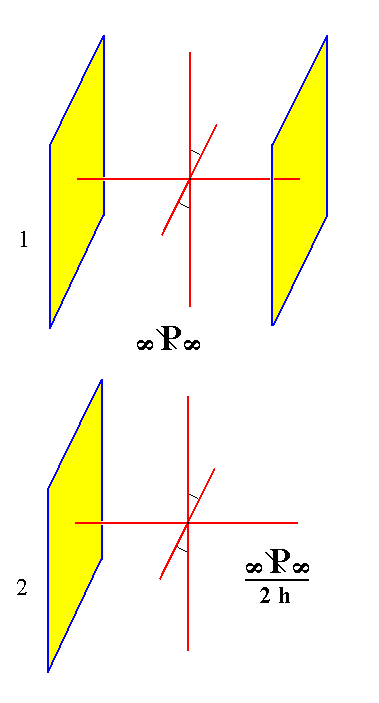 |
Figure 10. (1). The holohedric Monoclinic Clinopinacoid. (2). The Monoclinic Pedion. This Form consists of the left half of the holohedric Clinopinacoid. A second possible Form consists of the right half of the holohedric Clinopinacoid. When both occur on a real crystal then they still are two independent Forms. |
From the holohedric monoclinic orthopinacoid can be derived the hemimorphous monoclinic orthopinacoid when hemimorphy is applied. The Form does not change its external shape because the mirror plane which is to be suppressed is perpendicular to its faces. See Figure 11.
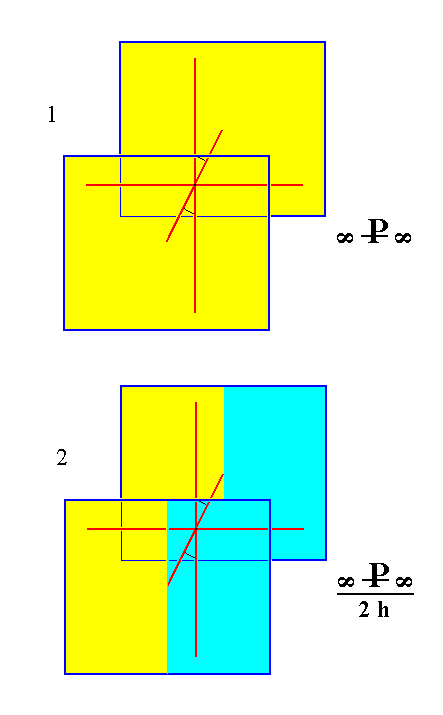 |
Figure 11. (1). The holohedric Monoclinic Orthopinacoid. (2). The hemimorphous Monoclinic Orthopinacoid. This Form consists of two faces parallel to the vertical and ortho axes. Its lowered symmetry is indicated by the coloring. |
From the holohedric monoclinic basic pinacoid, finally, we can derive the hemimorphous monoclinic basic pinacoid when it is subjected to hemimorphy. Because the mirror plane to be suppressed is perpendicular to its faces the Form does not change its external shape but the symmetry is lowered accordingly. So the hemimorphous Form still consists of two faces parallel to the clino and ortho axes. See Figure 12.
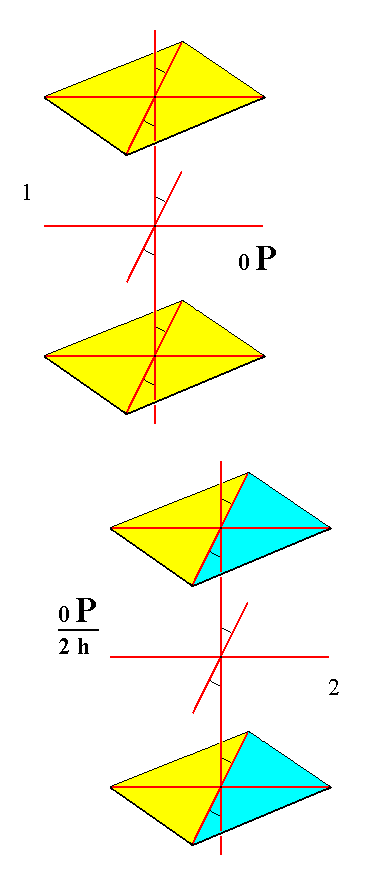 |
Figure 12. (1). The holohedric Monoclinic Basic Pinacoid. (2). The hemimorphous Monoclinic Basic Pinacoid. This Form consists of two faces parallel to the clino and ortho axes. Its lowered symmetry is indicated by the coloring. The red lines indicate crystallographic directions. |
This concludes our derivation of all the Forms of the Monoclinic-sphenoidic Crystal Class, by means of the merohedric approach.
All these Forms can (and in this case must) enter in combinations with each other in real crystals.
FACIAL APPROACH
We will now derive those same Forms from the basic faces compatible with the Monoclinic Crystal System, by subjecting these faces one by one to the symmetry elements of the present Class. The only symmetry element of this Class is a 2-fold rotation axis. The derivations will be shown by means of stereographic projections.
Recall from Part One that the basic faces were the following :
a : b : mc
na : b : mc
a : nb : mc
a : b : ~c
na : b : ~c
a : nb : ~c
~a : b : mc
a : ~b : mc
~a : b : ~ c
a : ~b : ~c
~a : ~b : c
The stereographic projection of the symmetry elements of the present Class and of all the faces of the most general Form (a monoclinic sphenoid) is given in the next Figure. Also the projections of the piercing points of the clino axis, i.e. the projections -- onto the projection plane -- of the points of intersection of the clino axis with the projection sphere, are given (Recall that the clino axis is not horizontal but tilted by the angle beta. This angle varies with the substance that is crystallized, and so does the location of the piercing points). See for further explanation of the stereographic projection of monoclinic crystals Part One.
 |
Figure 13. Stereogram of the symmetry elements of the Monoclinic-sphenoidic Crystal Class, and of all the faces of the most general Form. There is one 2-fold rotation axis (indicated by a pair of small solid ellipses) as being the only symmetry element of the Class. The projection of the piercing points of the clino axis ( = a axis ) is given in blue : the lower piercing point is represented by an open square, the upper piercing point by a solid square. |
The face a : b : mc generates a monoclinic prototetartopyramid (a monoclinic sphenoid) when subjected to the symmetry elements of the present Class : Rotation of the face by 1800 about the 2-fold rotation axis generates a second face such that the two faces intersect, forming the sphenoid. Figure 14 depicts this stereographically.
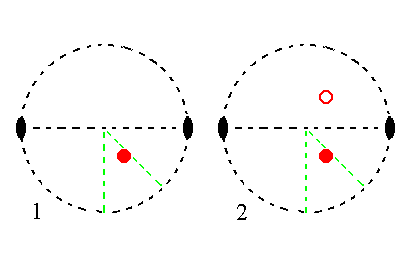 |
Figure 14. (1). Position of the face a : b : mc in the stereogram of the symmetry elements of the Monoclinic-sphenoidic Crystal Class. (2). The face is duplicated by the action of the 2-fold rotation axis resulting in a Monoclinic Sphenoid. |
The face na : b : mc generates a monoclinic clinotetartopyramid (a monoclinic sphenoid) when subjected to the symmetry elements of the present Class : The face is rotated 1800 about the 2-fold rotation axis resulting in a sphenoid. See Figure 15.
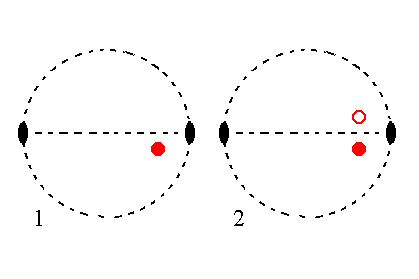 |
Figure 15. (1). Position of the face na : b : mc in the stereogram of the symmetry elements of the Monoclinic-sphenoidic Crystal Class. (2). The face is duplicated by the action of the 2-fold rotation axis resulting in a Monoclinic Sphenoid. |
The face a : nb : mc generates a monoclinic orthotetartopyramid (a monoclinic sphenoid) when subjected to the symmetry elements of the present Class : The face is rotated 1800 about the 2-fold rotation axis resulting in a sphenoid. See Figure 16.
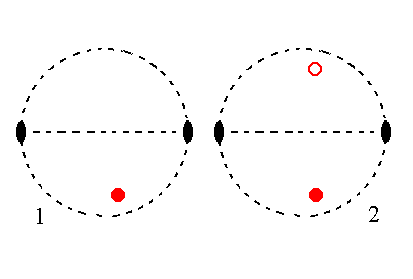 |
Figure 16. (1). Position of the face a : nb : mc in the stereogram of the symmetry elements of the Monoclinic-sphenoidic Crystal Class. (2). The face is duplicated by the action of the 2-fold rotation axis resulting in a Monoclinic Sphenoid. |
The face a : b : ~c is vertical. It generates a monoclinic protohemiprism when subjected to the symmetry elements of the present Class : The face is rotated 1800 about the 2-fold rotation axis resulting in a vertical face pair. See Figure 17.
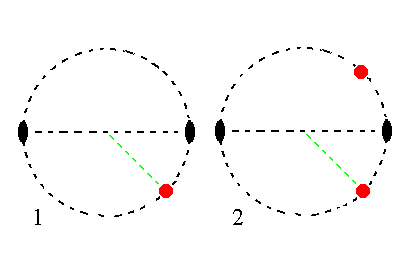 |
Figure 17. (1). Position of the face a : b : ~c in the stereogram of the symmetry elements of the Monoclinic-sphenoidic Crystal Class. (2). The face is duplicated by the action of the 2-fold rotation axis resulting in a Monoclinic Protohemiprism. |
The face na : b : ~c is also vertical. It generates a monoclinic clinohemiprism when subjected to the symmetry elements of the present Class : The face is rotated 1800 about the 2-fold rotation axis resulting in a vertical face pair. See Figure 18.
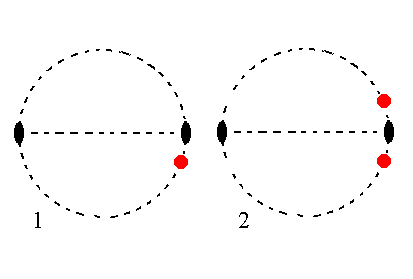 |
Figure 18. (1). Position of the face na : b : ~c in the stereogram of the symmetry elements of the Monoclinic-sphenoidic Crystal Class. (2). The face is duplicated by the action of the 2-fold rotation axis resulting in a Monoclinic Clinohemiprism. |
The face a : nb : ~c is also vertical. It generates a monoclinic orthohemiprism when subjected to the symmetry elements of the present Class : The face is rotated 1800 about the 2-fold rotation axis resulting in a vertical face pair. See Figure 19.
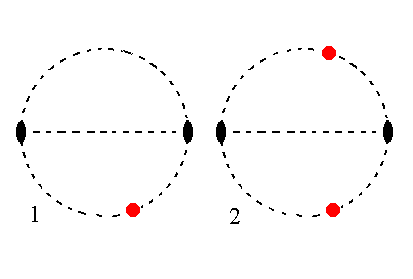 |
Figure 19. (1). Position of the face a : nb : ~c in the stereogram of the symmetry elements of the Monoclinic-sphenoidic Crystal Class. (2). The face is duplicated by the action of the 2-fold rotation axis resulting in a Monoclinic Ortohemiprism. |
The face ~a : b : mc is parallel to the clino axis. It generates a monoclinic clinohemidome when subjected to the symmetry elements of the present Class : The face is rotated 1800 about the 2-fold rotation axis resulting in a face pair parallel to the clino axis. See Figure 20.
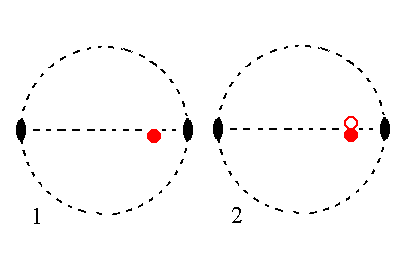 |
Figure 20. (1). Position of the face ~a : b : mc in the stereogram of the symmetry elements of the Monoclinic-sphenoidic Crystal Class. (2). The face is duplicated by the action of the 2-fold rotation axis resulting in a Monoclinic Clinohemidome. |
The face a : ~b : mc is parallel to the ortho axis. It generates a hemimorphous monoclinic orthohemidome when subjected to the symmetry elements of the present Class : The face is rotated 1800 about the 2-fold rotation axis resulting in a face pair parallel to the ortho axis.
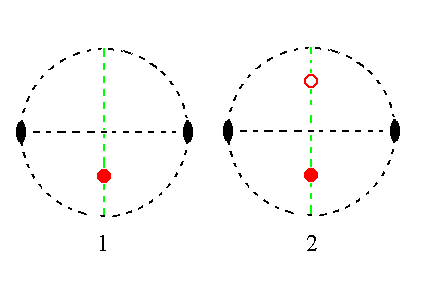 |
Figure 21. (1). Position of the face a : ~b : mc in the stereogram of the symmetry elements of the Monoclinic-sphenoidic Crystal Class. (2). The face is duplicated by the action of the 2-fold rotation axis resulting in a hemimorphous Monoclinic Orthohemidome. |
The face ~a : b : ~ c is parallel to the clino and vertical axes. It generates a monoclinic pedion when subjected to the symmetry elements of the present Class : The 2-fold rotation axis does not generate new faces, so we end up with that same initial face, the monoclinic pedion. See Figure 22.
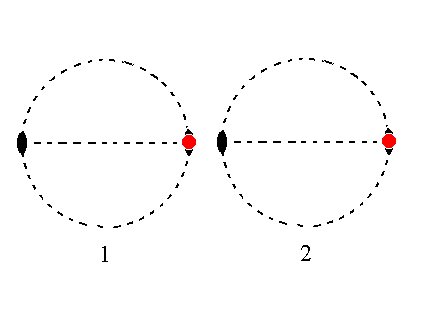 |
Figure 22. (1). Position of the face ~a : b : ~ c in the stereogram of the symmetry elements of the Monoclinic-sphenoidic Crystal Class. (2). The action of the 2-fold rotation axis does not have any effect, so the resulting Form is a single face parallel to the clino and vertical axes, a monoclinic pedion. |
The face a : ~b : ~c is parallel to the ortho and vertical axes. It generates a hemimorphous monoclinic orthopinacoid when subjected to the symmetry elements of the present Class : The face is rotated 1800 about the 2-fold rotation axis resulting in a vertical face pair parallel to the ortho axis. See figure 23.
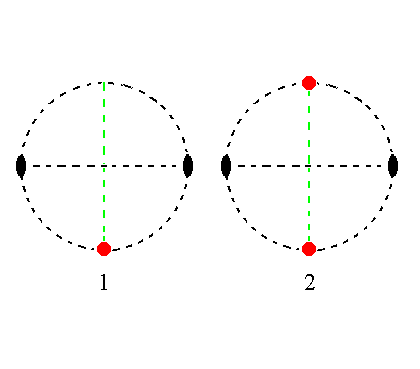 |
Figure 23. (1). Position of the face a : ~b : ~c in the stereogram of the symmetry elements of the Monoclinic-sphenoidic Crystal Class. (2). The action of the 2-fold rotation axis duplicates the face, so the resulting Form is a face pair parallel to the ortho and vertical axes, a hemimorphous Monoclinic Orthopinacoid. |
The face ~a : ~b : c finally, is parallel to the clino and ortho axes. It generates a hemimorphous monoclinic basic pinacoid when subjected to the symmetry elements of the present Class : The face is rotated 1800 about the 2-fold rotation axis resulting in a face pair parallel to the ortho and clino axes. See Figure 24.
 |
Figure 24. (1). Position of the face ~a : ~b : c in the stereogram of the symmetry elements of the Monoclinic-sphenoidic Crystal Class. (2). The action of the 2-fold rotation axis duplicates the face, so the resulting Form is a face pair parallel to the ortho and clino axes, a hemimorphous Monoclinic Basic Pinacoid. |
This concludes our exposition of the Monoclinic-sphenoidic Crystal Class.
To continue, klick HERE for Part Three (Class m).